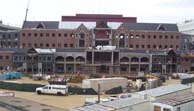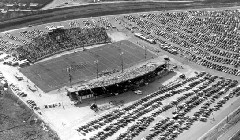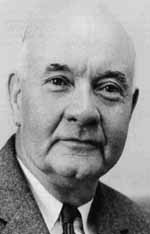
Doak Campbell Stadium - 2003
By Bill Bunker
8/2003
Editor's Note: Former Florida State University Sports Information Director Bill Bunker begins the first of a multi-part series on the history of Seminole Boosters, Inc., which raises funds for Seminole athletics.
Seminole Boosters, Inc. - The First Decade (1952-1959)
Consider the contrasts:
2003--Doak S. Campbell Stadium, capacity: 82,300. Florida State University: 36,683 students. Tallahassee population: 153,658. Football schedule: Atlantic Coast Conference plus Colorado, Miami, Notre Dame and Florida. Seminole Boosters, Inc., 15,700 members, worldwide, and a staff of 29 operates from offices in Florida State's University Center, the edifice that surrounds Campbell Stadium and may represent the organizations purest vision and finest effort. Last year's contributions and endowments, more than $27 million.
 |
Doak Campbell Stadium - 2003 |
1952--Doak S. Campbell Stadium, capacity: 15,500. Florida State University: 6,013 students. Tallahassee population: 36,000. Football schedule: Louisville, N.C. State and Georgia Tech join the Woffords and Stetsons in a definite upgrade. Seminole Boosters: In January, a group of Tallahassee businessmen and FSU faculty and staff met at the Los Robles home of Elberta Crate and Box Company President Jack Simmons to form a booster club to assist Florida State athletics which would raise $397 before year's end.
 |
Doak Campbell Stadium - 1953 |
It seems both Florida State University and Seminole Boosters, Inc. have been under construction ever since, achieving remarkable results from modest beginnings. FSU's academic and athletic stories are well-documented, how FSCW became Florida State University, fielded a football team, built a stadium and, under Head Coach Don Veller, dominated its small-college league.
The construction of the stadium in 1950 gave an early indication of the energy and enthusiasm Tallahassee could generate for FSU's young athletic program. Several key people were also instrumental in the formation of the boosters two years later...
One such was Rainey Cawthon, a former Florida football star. Under his leadership 1,000 5-year season tickets were sold in two months at $50 each. "This fine effort is especially noteworthy in view of the fact that many said a stadium with 15,000 seats was far more than Tallahassee would ever need," wrote FSU President Doak S. Campbell in his book, A University in Transition.
The stadium was built in five months for $157,670 on a cow pasture west of the FSU campus. The first steel arrived at
the pasture on July 5, and the first game was played under the lights on October 7. Before the end of the decade it would be expanded to 19,000 seats. Veller's
Seminoles went undefeated in 1950. "Bring on Florida," signs were hoisted at FSU's homecoming game. In that pivotal year in FSU history forces were at work that
would eventually make that dream a reality. The 1950 Florida Legislature passed an act allowing parimutuel tracks to hold scholarship days. With a source of
funds at hand, FSU announced in December, 1950, that it would begin awarding football scholarships, a decision pushed by Tallahassee civic boosters, but opposed
by a number of faculty, including Athletic Director Howard Danford, who believed that all sports were created equal. Danford was the architect of the
simon-pure Dixie Conference where FSU never lost a game during its four-year existence.
Dean Mode Stone In 1951, Bob Bannerman stepped into this transitional, super-charged atmosphere with an idea for a support
organization for FSU football. A native Tallahasseean, WWII vet, and recent FSU graduate, Bannerman sought and received Veller's blessing, then approached
President Campbell who not only approved, but guided him to seek faculty support from three strong deans, Mode Stone, Education, Coyle Moore,
Social Work, and Karl Kuersteiner, Music. These three men, particularly Stone and Moore, would exert great influence in shaping FSU's athletic
fortunes through the years. At the first official meeting Bannerman was elected President, Harold Carswell, vice president, Kuersteiner,
secretary and Zack Shelley, Sr., treasurer. In March, 1952, with 25 members present the name "Seminole Club" was selected, and a board of directors
was elected. Dues were set at $5 and a membership goal of 1,000 was set. It was decided that women could be members "on exactly the same basis as to men."
FSU Athletic Business Manager Ralph Matherly asked for help in selling season football tickets for the 1952 season. Raising money for FSU's football program was the overriding reason for formation of the Boosters, but football is
nowhere mentioned in the group's original constitution, perhaps an effort to soothe opposing elements at the university. The constitution's preamble states
the club's purpose was to "...promote, support, stimulate and assist the development of The Florida State University." Six standing committees were
established--Finance, Legislative, Athletic, Music and Arts, Publicity and Community-University Relationship. The club's first fund-raising effort was a
door-to-door blitz of downtown merchants seeking $5 and $10 donations. The total revenue for 1952, according to official Booster records, was $397. Nic Gavalas, a charter member who, as the owner of Nic's Toggery, was a target as well as a participant in
the early blitzes, remembers them well. "It was a tough sell," he said. "I remember going into barber shops trying to get $10. You might get it from the
owner, but that was a full day's work for a barber in 1952." There also was an effort, perhaps borrowed from similar programs in western schools, to implement a "Live Stock
Round-Up" program to get donated beef to feed the football team. The program's failure was announced early in 1953, the beginning of a new era for Seminole
football and its infant booster organization. Veller resigned as football coach following the 1952 season, but stayed to serve as associate athletic director and,
later, golf coach and became one of FSU most popular and enduring athletic figures. His replacement, Tom Nugent, whose VMI team had defeated the
Seminoles in '52, made his first appearance at the March meeting, attended by 21 people. Charles Rosenberg was elected president for the first of
two consecutive terms, and a new fund-raising method was launched. Businessman Albert Yates, a future Booster president, suggested a series of social gatherings as fund raisers,
reportedly quoting poet Ogden Nash, saying: "Candy is dandy, but liquor is quicker." Barbecues, fish frys, oyster roasts and other Booster parties, usually
staged in the back yards of members' homes, quickly became a popular part of Tallahassee's social scene. The parties could be rowdy, boisterous and fun, but with a serious bottom line. Rainey Cawthon became the "chief
extractor" of funds according to Bannerman who, before his death in June, 2003, told Tallahassee Democrat writer Gerald Ensley, "He was brutal in
raising money in a nice way. He would pit law firm against law firm, business against business. He was an artist at raising money." Timidity was not a virtue at these raucous affairs where well-lubricated arms were vigorously twisted. A common
practice was to plant pre-arranged bidders in the crowd to drive up pledges. The parties were thrown together on short notice whenever funds ran low. A
progress report in December, 1953, said that several parties were held at the homes of builder Syde Deeb and banker Julian Smith, raising
$15,000. On one occasion the Board noted plans for a party for "major contributors only." This fund-raising method didn't meet with universal approval in
"dry" Tallahassee where no liquor could be sold, when dining at the Silver Slipper or Joe's Spaghetti House meant bringing your alcoholic beverage in a brown
paper bag. On party days, cases of liquor arrived by Greyhound bus from Taylor County, the nearest "wet" county, recalls Jim
Tippen, a former FSU student body president who served briefly in 1953 as the Boosters' first executive secretary, then became a field secretary in the FSU
Alumni Office after Booster promises fell short of the mark. "They convinced me to drop out of graduate school to develop this thing," he said. "It was
glorious talk, but they couldn't pay me. I lost about 22 pounds during the six weeks I worked for them." With the Alumni Assn. Tippen put his undergraduate
experience in radio to work in lining up TV appearances for Nugent and taking the coach around the state to meet with alumni and form alumni clubs. The
support of the alumni office was invaluable in starting the Boosters and its continuing administrative support gave the young organization both a
headquarters and a staff. Booster founder Bannerman carried the interests of the club to his new job as assistant athletic business manager in
1953, and to his subsequent appointment as FSU's Director of Alumni Affairs, where he also served as Executive Secretary of Seminole Boosters, Inc., now a
non-profit corporation. This arrangement would continue throughout his tenure there as well as that of his successor, Tom Waits, who coordinated
Booster activities throughout the decade of the 1960s. With alumni support and the colorful Nugent as coach, both FSU football and the Seminole Boosters thrived in the
early '50s. President Spencer Burress, who succeeded Rosenberg, reported at the end of 1955 that since its beginning in 1952, membership had
increased from 65 to 800 and contributions from $397 to $23,116.25. Booster tags with accompanying stadium parking privileges, which were distributed for
the first time in 1954 had risen from 700 to 1,157. The first successful "Booster Blitz" was organized and carried out, and a direct mail campaign proved
effective, so much so that only one party was held that year. Since his arrival Nugent had goaded the University of Florida for a game. In February, 1955, the Board of Control
directed the two universities to play in all sports. That fall, FSU played its first season classified as a major college, and early in 1956 the first game
with Florida was scheduled to be played in Gainesville in 1958. Almost immediately Boosters began to use the game as a membership tool, requesting that all
5,000 allotted tickets be earmarked for members. Booster money then, as now, was used to supplement the budget of the athletic department. Then, most of it went to
defray the travel expenses of coaches on recruiting trips. Also, Booster money was used to pay transportation lodging and entertainment of recruits. At one
meeting, Nugent reported he wanted to bring in 300 players to sign 50 for the next season. At that time, Boosters and alumni were expected to actively
recruit high school players for the university. Without a full-time recruiter and with a limited travel budget, they were the eyes and ears of the coaching
staff statewide. Jobs for players were also a major item requested by coaches, and the Boosters were pressured to provide those. Contributions reached a plateau in 1955 and would stay in the $20,000 neighborhood for the remainder of the decade,
save for a boost to $30,692 in 1959, boosted by the success in Nugent's final season which featured a victory over Tennessee and the first game against
Florida. Payne Midyette, Sr., 1956, Albert Yates, 1957, and W.G. "Babe" Starry, 1958-9, kept the ship on course. Doak Campbell retired
in 1957, leaving legacy of contributions for the university and its athletic program. Perry Moss's single season as FSU football coach in 1959
survives as little more than a footnote today. Seminole Boosters, Inc., finished the '50s as it had begun, essentially a Tallahassee civic organization. As Jim
Joanos remarked in his "Garnet and Old" column in this publication in 2001, "A literal 'Who's Who' of the Tallahassee business community was involved
in the early Booster activities." Many of them were University of Florida graduates who supported FSU's fledgling program because they felt it was good for
the community. Most of the founders and pioneers are gone now, but take an evening's drive in Tallahassee with your windows rolled
down and your imagination turned up. Drive through Betton Hills, Los Robles, Waverly Hills or other popular upscale neighborhoods of the day, and listen
for the clink of glasses, the strident challenges of the "extractors" and the cheers urging bigger and bigger contributions. Listen for the sounds of a
dynasty's birth. Next: Bill Peterson demands, Seminole Boosters respond, and Florida State hits the big time.
